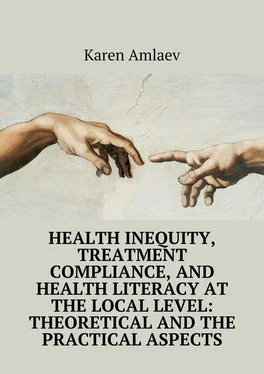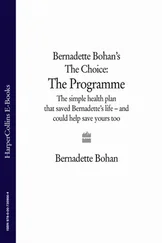Karen Amlaev - Health inequity, treatment compliance, and health literacy at the local level - theoretical and practical aspects
Здесь есть возможность читать онлайн «Karen Amlaev - Health inequity, treatment compliance, and health literacy at the local level - theoretical and practical aspects» — ознакомительный отрывок электронной книги совершенно бесплатно, а после прочтения отрывка купить полную версию. В некоторых случаях можно слушать аудио, скачать через торрент в формате fb2 и присутствует краткое содержание. ISBN: , Жанр: sociology_book, Детская образовательная литература, foreign_language, Прочая научная литература, на английском языке. Описание произведения, (предисловие) а так же отзывы посетителей доступны на портале библиотеки ЛибКат.
- Название:Health inequity, treatment compliance, and health literacy at the local level: theoretical and practical aspects
- Автор:
- Жанр:
- Год:неизвестен
- ISBN:978-5-4474-2118-2
- Рейтинг книги:4 / 5. Голосов: 1
-
Избранное:Добавить в избранное
- Отзывы:
-
Ваша оценка:
- 80
- 1
- 2
- 3
- 4
- 5
Health inequity, treatment compliance, and health literacy at the local level: theoretical and practical aspects: краткое содержание, описание и аннотация
Предлагаем к чтению аннотацию, описание, краткое содержание или предисловие (зависит от того, что написал сам автор книги «Health inequity, treatment compliance, and health literacy at the local level: theoretical and practical aspects»). Если вы не нашли необходимую информацию о книге — напишите в комментариях, мы постараемся отыскать её.
Health inequity, treatment compliance, and health literacy at the local level: theoretical and practical aspects — читать онлайн ознакомительный отрывок
Ниже представлен текст книги, разбитый по страницам. Система сохранения места последней прочитанной страницы, позволяет с удобством читать онлайн бесплатно книгу «Health inequity, treatment compliance, and health literacy at the local level: theoretical and practical aspects», без необходимости каждый раз заново искать на чём Вы остановились. Поставьте закладку, и сможете в любой момент перейти на страницу, на которой закончили чтение.
Интервал:
Закладка:
Health inequity, treatment compliance, and health literacy at the local level: theoretical and practical aspects
Karen Amlaev
© Karen Amlaev, 2015
© Vlad Babayants, translation, 2015
Created with Ridero
Foreword by the leader of the WHO Healthy Cities project
Healthy Cities since its inception 25 years ago has put a strong emphasis on equity and strategies and interventions aimed to support individuals and communities have more control on decisions and developments that affect their health and wellbeing. Health literacy is increasingly recognized as a very promising domain of public health and health promotion. It is an important component in our strategies to promote empowerment and community resilience.
Translating theory and evidence into local practice can be challenging. Concepts need to be expressed and understood in professional terms that are used locally. Recommendations and frameworks for action need to be adapted to local political and organizational contexts and realities. The support of local academic institution can be vital in such efforts.
The monograph at hand prepared by Karen Amlaev, Member of the European Advisory Committee, Professor of the Stavropol State University is a good example of an endeavour to address equity and health literacy in Stavropol, linking theory and evidence with situation analyses and action plans.
I should like to congratulate professor Karen Amlaev for this initiative and his commitment to supporting the Stavropol Healthy Cities project and the work of the Russian Healthy Cities network and beyond.
Dr Agis Tsouros Director Division of Policy and Governance for Health and Well-being World Health Organization’s Regional Office for Europe CopenhagenIntroduction
The project Healthy Cities has been making its contribution to health promotion in the European Region for several decades now. The peculiar feature of it is proper response to the issues arising in public health and healthcare systems in European countries. This is reflected in the topics that are taken as key ones at certain stages of the Healthy Cities project.
The Russian Federation has been an active member of the European network of Healthy Cities and dozens of Russian cities have joined our movement in the latest years.
The monograph presented here focuses on relevant issues of modern healthcare – health inequity, low health literacy and treatment compliance.
Health inequity has become one of the key priorities for the European Strategy 2020. Even though the health status indicators, such as the death rate, are improving all over Europe there are still sharp health differences between countries, inside countries, and even between cities and social groups. Unfortunately, health inequity is increasing the global economic recession being among the key causes here. The growing unemployment and cut budgets on public needs will affect millions of people’s living conditions in Europe, and will have the greatest impact on the health status of the most vulnerable groups. Should there be no timely and proper measures taken this health inequity may only increase.
The issues of low health literacy and treatment compliance, even though seemingly belonging to a different area, yet are indirectly linked to the issue of health inequity. It is obvious that improving literacy among the population in general and especially among its most vulnerable groups (socially disadvantaged) would add to the local community resilience against the socio-economic negative effects of the crisis, as well as contribute to the reduction of health inequity.
On the other hand a higher level of health literacy will improve patients” treatment compliance, which allows gaining better results in terms of improving people’s health status with no financial cost. Our research demonstrates that the compliance among the vulnerable groups (low-income and those with a low level of education) is poorer than among other groups. This means that improved health literacy and treatment compliance would also promote reduction of health inequity.
This entire range of issues with their potential solution is reflected in this monograph. The book offers a theoretical overview of the current state of the issue as well as provides the author’s own findings and the experience of the City of Stavropol gained due to the participation in the Healthy Cities project. This monograph would make a good reading for politicians and specialists representing various professional areas (healthcare, education, etc.) whose activities have an impact on people’s health in any way.
Health inequity
The current state
Health inequity: political and social aspects
Literature will often use the term HEALTH INEQUITY as a synonym to HEALTH INJUSTICE. However, these terms are not similar. Since health inequity is a general term typically used to define differences, changes, and disproportions in the health status of individuals and groups not any health inequity will be unjust. Yet, many types of health inequity are undoubtedly unjust as the concept of health injustice focuses on distribution of resources and other processes that drive certain types of health inequity, i.e. on systematic disparities in terms of health (or in its social determinants) among various social groups enjoying more or less favorable opportunities. In other words it focuses on health inequities that are unjust and unfair.
Speaking of the English terms “inequality” and “inequity” that are used to define “disparity”: in healthcare the expression social inequalities in health imply the same disparity [just like social inequities in health ], which is unfair and unjust” (Whitehead and Dahlgren, 2008).
Some researchers suggest a definition based on which unfairness in health will be related to those health disparities that are considered avoidable, removable, unfair and unjust (Braveman P. et al, 1996, 2001; Newton K.,1997; Anand S., 2002; Whitehead and Dahlgren, 2008).
Health inequity is increasing both inside countries and among them. Besides, in all countries there is a large gap in terms of health status dividing various groups irrespective of their income. In high income countries there can be observed a more than 10-year life expectancy gap between various groups depending on such factors as the ethnicity, gender, social & economic status, and the geography of residence. In poor countries all regions show significant difference in child death rate depending on the household welfare.
Socio-economic conditions (social determinants) have a significant impact people’s health through their entire life-span. People with lower income demonstrate at least twice the likelihood of developing a serious disease or premature death if compared to those with high income. Besides, the social disparities in health status, which could be called the social health gradient, can be observed through all the stages of the social ladder and go beyond the low-income group. In particular, even in the middle class those with lower positions contract diseases and die more often than their colleagues holding higher positions (Whitehead M., Dahlgren G., 2008).
When viewing the behavioral factors – either positively or negatively affecting health – we shall come across numerous undeniable facts showing that poorer (from socio-economic point of view) groups usually demonstrate poorer nutrition, lower physical activity at their spare time, have a higher level of tobacco use or some other alcohol-related behavior patterns that seriously affect health. Special literature available reflecting the findings received from qualitative research into poorer groups” living conditions and lifestyles, serves evidence that such people have more restricted choices in terms of healthy lifestyles, which is due to the limits on their time, space, and money available to them, and could also be accounted for by the psycho-social mechanisms influencing them. All this is aggravated with the difference in access to goods, conditions and services, which could prevent or reduce the health damage from the socio-economic factors. For instance there are differences about access to the major medical care and their quality when we talk of various groups of the society, where healthier and better-off groups enjoy more of that access. The same holds true both for preventive services and for treatment (Whitehead and Dahlgren, 2008).
Читать дальшеИнтервал:
Закладка:
Похожие книги на «Health inequity, treatment compliance, and health literacy at the local level: theoretical and practical aspects»
Представляем Вашему вниманию похожие книги на «Health inequity, treatment compliance, and health literacy at the local level: theoretical and practical aspects» списком для выбора. Мы отобрали схожую по названию и смыслу литературу в надежде предоставить читателям больше вариантов отыскать новые, интересные, ещё непрочитанные произведения.
Обсуждение, отзывы о книге «Health inequity, treatment compliance, and health literacy at the local level: theoretical and practical aspects» и просто собственные мнения читателей. Оставьте ваши комментарии, напишите, что Вы думаете о произведении, его смысле или главных героях. Укажите что конкретно понравилось, а что нет, и почему Вы так считаете.












